 |
 |
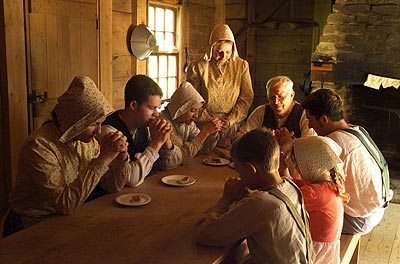 1 1 |
Acadians didn't have a hard time. Despite the intense cold and the long winters, the smallpox, the dysentery, the high rate of infantile mortality, the fight against the Nature and the deportations, one might say that they didn't live so badly. On the other hand, enjoying of a warming familiar union, having beautiful houses with gardens, farms, cattle and cultures, eating the fresh fruits of the forest, to be sitting every night close to the fire hearing the old men tales, to be fed with excellent French food, wearing the last fashion of France, and to stay relaxed on the ample lands of the American continent, would be the positive side of a life focused toward adventure and progress. |
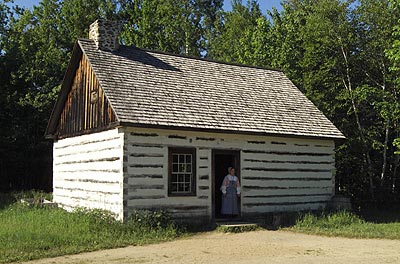 2-Maison Mazerolle |
The Acadian Habitat. |
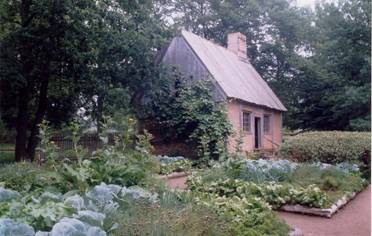 3 House and garden |
|
Even though in Louisbourg we can find in 1730 some constructions made of stone, in the rest of the Nouvelle France, wood was the most used material . Also were made of wood houses of Saint Pierre Et Miquelon, but in addition a “drum” was used there in the frontal door to protect them of the cold. In the later part, always there was a farm for its cultures and a stable for the animals.
|
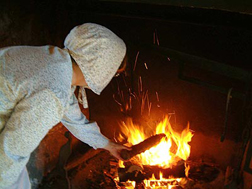 7 |
THE ACADIANS' DIET: |
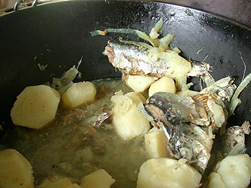 Mackerel stew. |
|
THE LIFE IN THE CYCLES OF THE YEAR: Winter used to last 5 or 6 months, and during long time the snow covered everywhere. The snow storms were frequent. When the autumn begun, the arrival of the cold weather was marked by the necessary tasks for the subsistence: preparation of seeds and cultures, animal slaughter, jelly made from fruits of the forest, conservation of fish. During the winter they used to live in interiors, the men taking care of the animals and women preparing clothes with the wool, fabrics and the skins of animals obtained in spring. When arriving the spring, all returned at their tasks: the harvest, the harvesting of fruits of the forest, and the beginning of the fishing, that lasted all along the summer. |
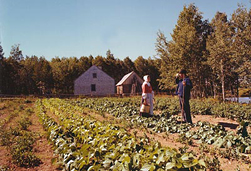 |
|
THE MEDICINES: The greater problems of diseases came brought in the boats that arrived worldwide, by the marine commerce: the plague, the smallpox, dysentery, typhus and other contagious diseases. The rate of infantile mortality was high, caused by infections. The most frequent illnesses, treated by the medicine of the 18th century, were flu, dental problems, abscesses and ulcers. They had civilian and military surgeons, and druggists.
|
FOLKLORE AND
RELIGION:
The main element of the
Acadian culture was their catholic religion, with deep submission to the
authority of the Pope and the Virgin Mary. The churches and the priests
maintained the conservation of the customs and the care of the moral, and
even they took part on particular litigations. The religious holidays were
respected, and all the civil acts of the community were registered and
celebrated by the Church. The Church also filed carefully civil documents,
to control that there were not too many marriages between close relatives,
inevitable situation in those small communities. |
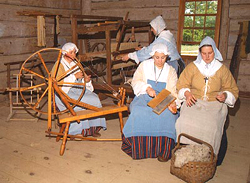 9 9 |
TEXTILES and VESTMENTS:
From the beginning, the wool and the linen
were the main materials used for the manufacture of clothes. Towards aims
of XVIII century they incorporate the cotton. Durable, simple, their
clothes made by hand offer a great freedom of movements. In the
dresses they maintain traditional norms: to each one, according to the
moral and social norms of the time, a habit corresponds ; whoever who
wanted to distinguish itself by its clothes will be sanctioned by the
religious norms. Men seed the linen in May, and come to the dye of the
skins of ewe and bovines stored from the winter. The women make the work
of rebuke, the spinning, and the completion of the clothes. In their more
traditional clothes, always predominate black and
red colors. In their contact with the Indians of the zone, the Micmaqs,
Acadians learn the manufacture of a footwear that will become famous by
ever: the moccasin. |
 10 10 |
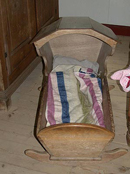 11 |
QUOTIDIAN LIFE AND FAMILY:
The family was the pillar on which all
the Acadian community was based. Typically composed of father, mother, and
many children, were the patrimonial and cultural message center of the
community. The marriage was the form to extend the communitarian network
and to conserve the subsistence. The average of marriages was between
people of more or less the same age, generally the man few years greater
than the woman. The women did not marry as young as in France, (where at
that time we found many married to the 16 years), but, generally, around
the 20 years of age. But spent the 25 years of age, if they were
unmarried, they had to be resigned to their role of aunts or to find a
religious vocation. The passage to the adolescence was given by the Solemn Communion, that was at 14 years for the girls and at
16 years for the boys. It is to emphasize that when a young couple
married, all the community contributed to construct the new home, donating
the materials and the work. |
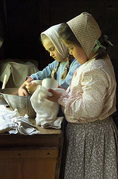 12 |
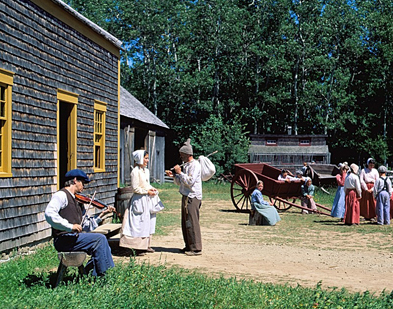 |
Report about the Acadians, written in 1790: It was written in 1790 by Moses Delesdernier, original from Suisse who arrives at Nova Scotia in 1750. He was living at that time in company of acadians of Pisiquid, a part of Windsor nowadays. At the request of Dr. Andrew Brown, from Halifax, who was doing a vast research about acadian life, he was sent to make what he called "Observations of the Situation, Customs and Manners of the Ancient Acadians", from where we have these excerpts : "The Acadians are the most innocent and virtuous people whom I have ever known or heard tell of in any history. They live in a state of perfect equality, without distinction of rank in society. The title of 'Messieurs' is not known among them. Ignorant of the luxuries and even of the conveniences of life, they are content with a simple mode of life, which they easily derive from the cultivation of their lands. Very little ambition or avarice was seen among them; they helped each other's wants with benevolent liberality; they required no interest for loans of money or other property. They were humane and hospitable to strangers, and very liberal to those who embraced their religion. They were very remarkable for the inviolable purity of their morals. I do not recollect a single case of illegitimate births among them, even now. Their knowledge of agriculture was very limited, although they cultivated their dyked lands pretty well....Each farmer was his own architect, and each proprietor was a farmer...They raised and made their own clothing, which was uniform. They were fond of black and red with stripes down the leg, bunches of ribbons and long streamers...They were a strong, healthy people, capable of enduring great hardship, and generally lived to an advanced age, although no one employed a doctor.... To conclude, they seemed always cheerful and light-hearted, and on every occasion were unanimous. If any disputes arose in their transactions, etc., they always submitted it to arbitration, and their last appeal was to the priest. Although I have seen cases of mutual recrimination on returning from these decisions, you seldom, if ever, discovered among them any thought of malice or vengeance." |
 |
CONSTRUCTION OF DIKES:
Reproduction of the artist Azor Vienneau ( Nova Scotia Museum) |
|
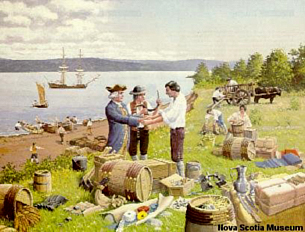 |
THE COMMERCE: Although the Acadians were remarkably self-sufficient there were some things they could not make or grow themselves, and for these needs they established trading links with New England and with other French settlements. Molasses, cooking pots, board axes, clay pipes, gunpowder, fabrics, and rum came through New England. Through Louisbourg they obtained cottons, thread, lace, firearms and religious items from France. The Acadians were fond of smoking (both men and women smoked): their clay pipes came mostly from England, although at times they did make their own, using local red clay. In return for these items, the Acadians traded grain from the fertile marshlands, cattle well-fed on salt-marsh hay, and furs they had obtained from trapping and trade with the Mi'kmaq. The fur trade brought 150.000 pounds yearly only on the Valley of St Jean. <Photo at the left: Reproduction of the artist Azor Vienneau (Nova Scotia Museum)
|
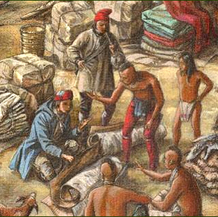 |
|
Many
a weary year had passed since the burning of Grand-Pre,
Friendless, homeless, hopeless, they wandered
from city to city, From the epic poem "Evangeline, a Tale of Acadie" written by Henry Wadsworth Longfellow in 1847. The poem tells the story of Evangeline, who is separated from her husband and she finally finds him in the instant of his death.
|
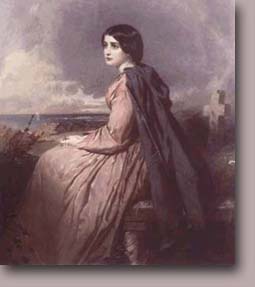 |
|
Sources: "Les émigrés français en Acadie: leur vie quotidienne", Michèle Champagne - "Acadie- La vie quotidianne au temps de nos âncetres" - Village Virtuel Historique Acadien. - La Cigogne et le Caribou (http://lacigogneetlecaribou.kazeo.com/Acadie/Les-Acadiens-Partie-II,a555199.html). Photos: (Courtesy Village Virtuel Historique Acadien): 1- Grace before meal, 2- Maison Mazzerolle, 3- House and garden, 4- Master bedroom; Thèriault House,- 5- Corner cupboard; Babineau House,- 6- Sweeping the floor.- 7- Feeding the fire in the hearth-, 8- Fricot de maquerole, 9- The processing of wool,- 10) Dancer, 11) Cradle,- 12- Young girls doing the dishes. Midi: "Overture" (Traditional acadian songs) Arrangement by Barry Taylor - "The Great Canadian Tunebook" - http://www.members.shaw.ca/tunebook/index.htm |